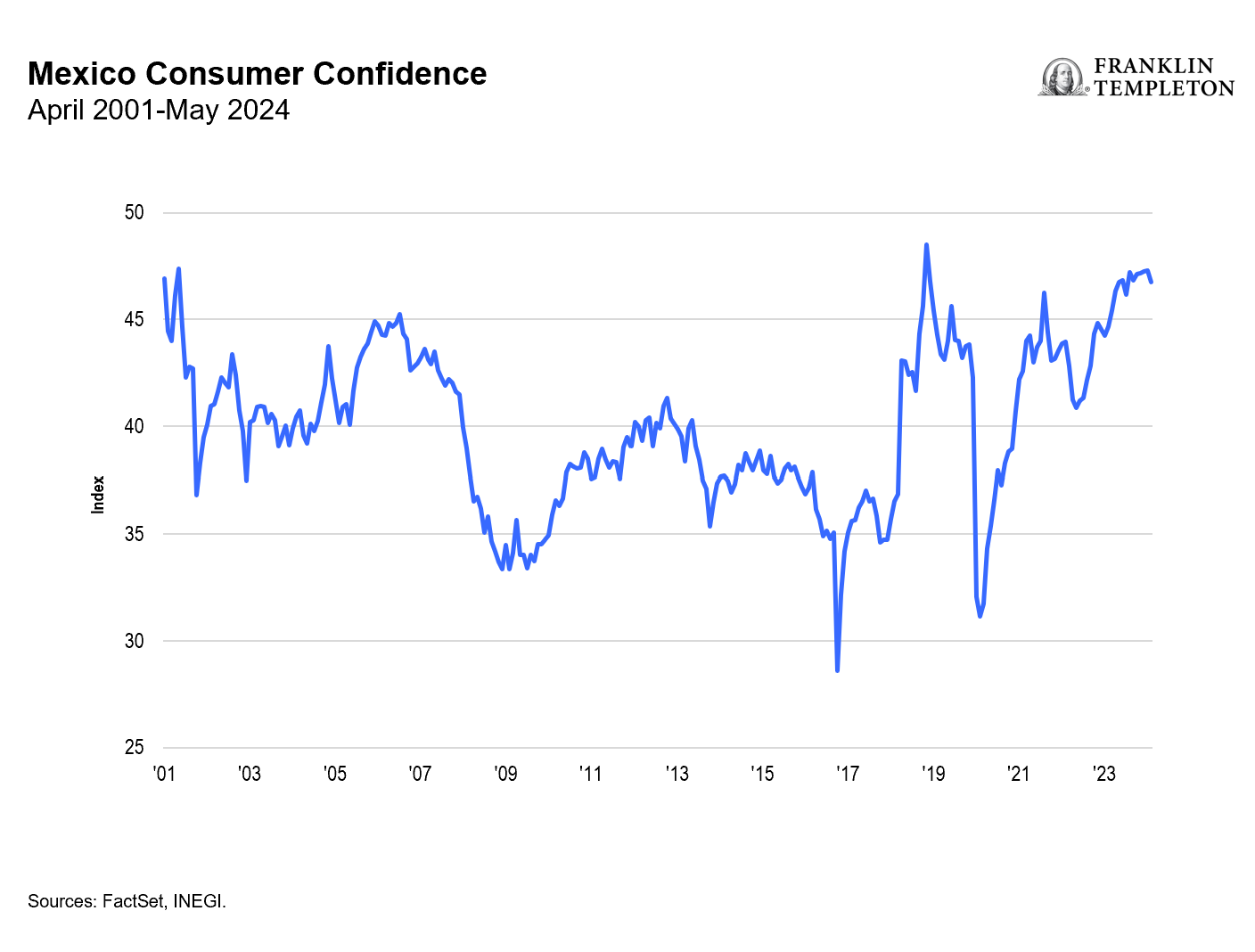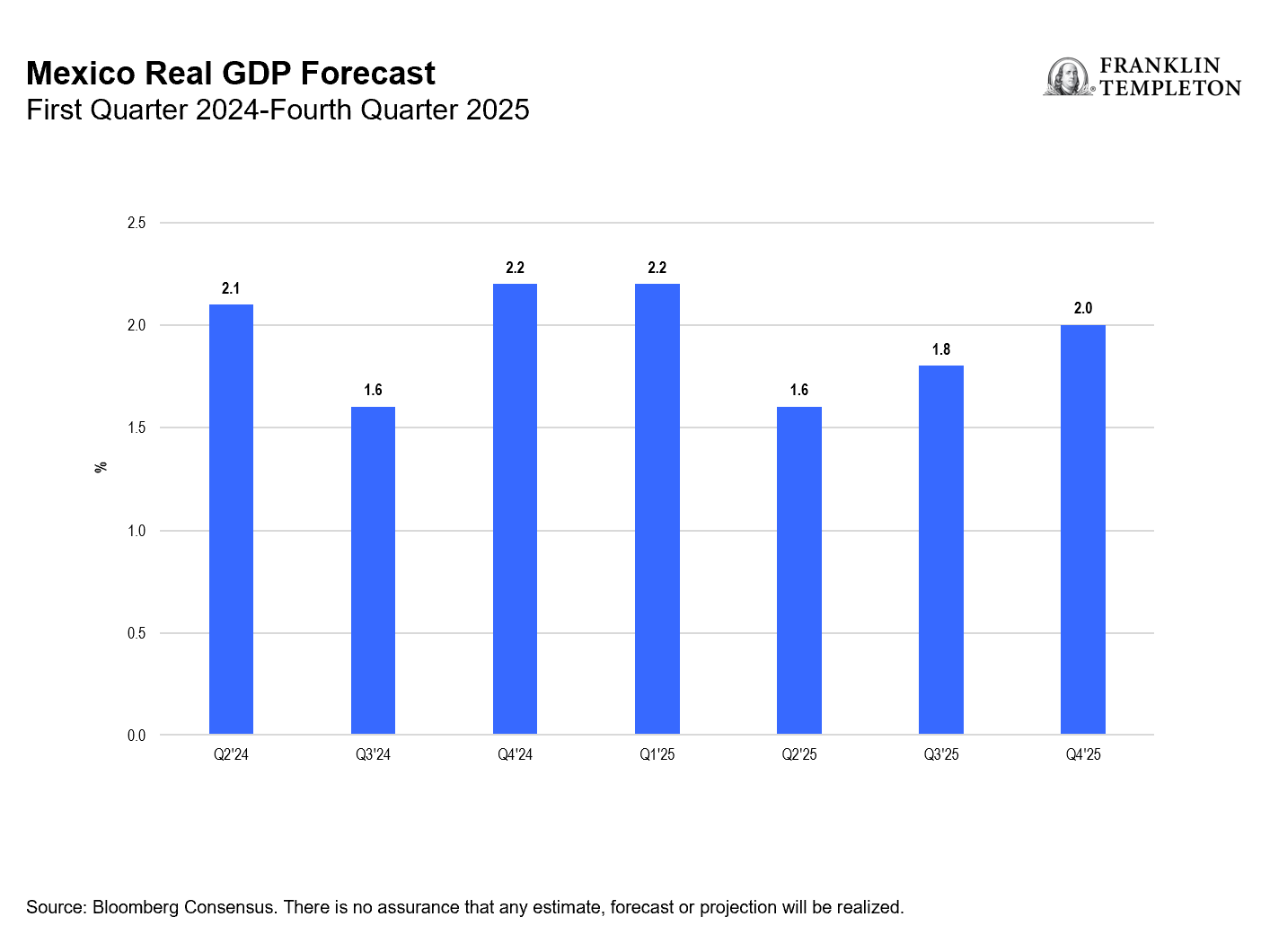Just how well—or not so well—Mexico’s President-elect Claudia Sheinbaum may be able to tackle the country’s prevailing challenges is still up for debate. Sheinbaum’s commanding margin of victory in the June election discouraged some investors amid fears that her ruling Morena party could potentially push through constitutional reforms that may adversely impact Mexico’s business environment.
Since the outcome of the US presidential election will remain undecided for a month after Sheinbaum takes office in October, we expect Mexico’s equity markets to experience more short-term market volatility. But given Mexico’s ongoing potential to capitalize on nearshoring investments and Sheinbaum’s track record of progress during her time as mayor of Mexico City (beginning in 2018), we think investors should be monitoring opportunities to enter this compelling market. We believe a continuation of US macro drivers are still poised to drive Mexican exports. Although US appetite for Chinese imports was still high even as recently as 2022, the drop-off in trade with China since then has benefited Mexico, which recently eclipsed both China and Canada to become the biggest US trade partner.1
Mexico’s first female president
A protégé of outgoing President López Obrador (or AMLO as he is known), Sheinbaum has pledged to continue along the political course of her predecessor. But as a climate scientist with a Ph.D. in environmental engineering, she appears to us to be more attuned to pressing issues, such as Mexico’s water woes and efforts toward the energy transition. She has demonstrated deep, technical expertise and perspective on vital issues—“not simply as stewardship of natural resources, but also as an issue interconnected with education, social justice, health care, housing and infrastructure,” according to the think tank Atlantic Council.2
There is hope that the public-private partnerships that Sheinbaum advanced during her time as Mexico City’s mayor could be a model that she adopts and adapts in her new administration to increase the number of strategic projects. These may include opening natural gas production and transportation to private participants, boosting infrastructure and more renewable energy projects that are critical for Mexico to take advantage of nearshoring-related investment opportunities.
Since renewables like solar and wind currently make up only about 12% of the electricity mix in Mexico (significantly lagging the 16% share for the United States), there is great potential for the country’s clean energy buildout.3 Sheinbaum has pledged to change course from AMLO in her approach to speeding the promotion of renewable energies with a US$13.6 billion investment plan through 2030 that includes pioneering development of smart grids and other green technologies. Experts have praised Sheinbaum’s methodical approach to governance, for example, bringing stability and predictability to regulatory frameworks with her technical background and reliance on seasoned advisors.
Among some of the moderate-to-high risks for Mexico is public security and crime. Here again, Sheinbaum’s approach in working with US counterparts during her tenure in Mexico City has been applauded. Her cabinet picks for key positions thus far present an even gender distribution and draw from academia and her mayoral administration—in a bid to repeat the successes in crime-fighting she achieved during her years as mayor. These include veteran politicians Omar Garcia Harfuch for Security Minister, Marcelo Ebrard for Secretary of Economy and Alicia Barcena for Secretary of Foreign Affairs.
Mexico poised for economic growth
Over the near term, Mexico is expected to achieve a 2% growth rate—higher than its 20-year average.4 Although Mexico’s headline inflation accelerated beyond analyst expectations in June, its strong trend of domestic demand and high consumer confidence should also offer some economic momentum, in our opinion. For example, June auto sales were up 8.3% from a year earlier, according to government data.
It’s also important to recognize that Mexico is the second-highest receiver of remittances—transfers of money from migrants working abroad—in the world, behind only India. For the decade leading up to 2020, the percentage of households in Mexico that received remittances rose to 5.1% from 3.6% in 2010.5 Last year, remittances to Mexico notched a 7.6% increase, hitting a record US$63 billion, due to a strong US labor market.6
Exhibit 1: Mexico Consumer Confidence

Exhibit 2: Mexico Real Gross Domestic Product (GDP) Forecast

Investors seeking exposure to Mexico’s market through broad emerging market indexes, like the MSCI Emerging Market (EM) Index, gain less than a 3% weighting to Mexico.7 And while China’s dominant share of the benchmark is lower now than in recent years, it still presents a 25% weighting, which may be more than investors want.8 In our opinion, single-country exchange-traded funds offer a compelling way for investors to layer targeted access to a country’s large- and mid-sized companies at a low cost.
As of the end of June, Mexico’s main benchmark stock index, the IPC, held a 33% weighting in the consumer staples sector.9 Materials and financial sector stocks make up the next biggest weighting at about 19% each.10
As Mexico continues to play a larger role in global supply chains, investors should note corporate nearshoring progress as gauged by the country’s foreign direct investment (FDI) trends. At the end of 2023, Mexico ranked ninth among the world’s largest recipients of FDI, receiving investments of US$36 billion—about 2% more than in the prior year.11 Longer term, we believe nearshoring efforts, to diversify and improve the security of supply chains, remain a key tailwind for Mexico’s economy and markets.
WHAT ARE THE RISKS?
All investments involve risks, including possible loss of principal.
Equity securities are subject to price fluctuation and possible loss of principal. International investments are subject to special risks, including currency fluctuations and social, economic and political uncertainties, which could increase volatility. These risks are magnified in emerging markets. Investments in companies in a specific country or region may experience greater volatility than those that are more broadly diversified geographically.
IMPORTANT LEGAL INFORMATION
This material is intended to be of general interest only and should not be construed as individual investment advice or a recommendation or solicitation to buy, sell or hold any security or to adopt any investment strategy. It does not constitute legal or tax advice. This material may not be reproduced, distributed or published without prior written permission from Franklin Templeton.
The views expressed are those of the investment manager and the comments, opinions and analyses are rendered as at publication date and may change without notice. The underlying assumptions and these views are subject to change based on market and other conditions and may differ from other portfolio managers or of the firm as a whole. The information provided in this material is not intended as a complete analysis of every material fact regarding any country, region or market. There is no assurance that any prediction, projection or forecast on the economy, stock market, bond market or the economic trends of the markets will be realized. The value of investments and the income from them can go down as well as up and you may not get back the full amount that you invested. Past performance is not necessarily indicative nor a guarantee of future performance. All investments involve risks, including possible loss of principal.
Any research and analysis contained in this material has been procured by Franklin Templeton for its own purposes and may be acted upon in that connection and, as such, is provided to you incidentally. Data from third party sources may have been used in the preparation of this material and Franklin Templeton (“FT”) has not independently verified, validated or audited such data. Although information has been obtained from sources that Franklin Templeton believes to be reliable, no guarantee can be given as to its accuracy and such information may be incomplete or condensed and may be subject to change at any time without notice. The mention of any individual securities should neither constitute nor be construed as a recommendation to purchase, hold or sell any securities, and the information provided regarding such individual securities (if any) is not a sufficient basis upon which to make an investment decision. FT accepts no liability whatsoever for any loss arising from use of this information and reliance upon the comments, opinions and analyses in the material is at the sole discretion of the user.
Products, services and information may not be available in all jurisdictions and are offered outside the U.S. by other FT affiliates and/or their distributors as local laws and regulation permits. Please consult your own financial professional or Franklin Templeton institutional contact for further information on availability of products and services in your jurisdiction.
CFA® and Chartered Financial Analyst® are trademarks owned by CFA Institute.
__________
1. Source: US Census Bureau 2023.
2. Source: Atlantic Council, May 17, 2023.
3. Source: “Mexico is yet to harness its high potential for cheap, clean solar and wind energy.” Ember. May 2024.
4. Source: Bloomberg, July 2024.
5. Source: Mexico’s Central Bank (Banxico).
6. Ibid.
7. Source: Morningstar, June 30, 2024. The MSCI EM Index captures large- and mid-cap representation across 24 EM countries. With 1,330 constituents, the index covers approximately 85% of the free float-adjusted market capitalization in each country. Past performance is not an indicator or a guarantee of future performance. Indexes are unmanaged and one cannot invest directly in an index. Important data provider notices and terms available at www.franklintempletondatasources.com.
8. Ibid.
9. Source: GrupoBMV. The Mexican IPC index (Indice de Precios y Cotizaciones) is a major stock market index, which tracks the performance of leading companies listed on the Mexican Stock Exchange. It is made up of a selection of shares that are representative of all the shares listed on the exchange from various sectors across the economy. It is a capitalization-weighted index. Past performance is not an indicator or a guarantee of future performance. Indexes are unmanaged and one cannot invest directly in an index. Important data provider notices and terms available at www.franklintempletondatasources.com.
10. Ibid.
11. Sources: United Nations Conference on Trade and Development and Mexico Ministry of Economy.

 English
English 简体中文
简体中文